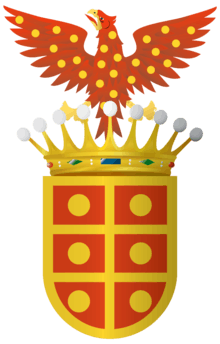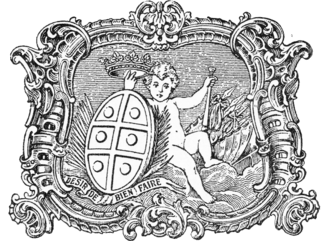Count of Avintes
| County of Avintes | |
|---|---|
 Coat of Arms of the Counts of Avintes | |
| Creation date | 17 February 1664 |
| Monarch | King Afonso VI of Portugal |
| Peerage | Peerage of Portugal |
| First holder | D. Luis de Almeida |
| Present holder | D. Luís Maria de Almeida |
| Heir apparent | D. Jaime de Almeida |
Count of Avintes is a title in the Peerage of Portugal created by Letters Patent of King Afonso VI of Portugal on 17 February 1664 for D. Luis de Almeida, 5th Lord of Avintes. The title was conferred in perpetuity[lower-alpha 1] upon the 4th Count by King José I of Portugal in the same document by which he was elevated to the Marquessate of Lavradio,[1][2] later confirmed by Letters Patent dated 29 August 1766.[3]
Background
It is possible that the ancient Seigniory of Avintes predates the foundation of Portugal itself.[4] In 1505, the benedictine Monastery of Saint Thyrsus, which had held it since the end of the XIII century,[5] confirmed the Seigniory had been passed to the Brandão family in the person of Fernão Brandão Pereira, Knight Commander of São Martinho de Salreu in the Order of Santiago and a nobleman at the Court of King Manuel I. He was later appointed chamberlain to Prince Fernando, and was King João III's ambassador to the King of Fez. His heirs would continue to hold important positions at Court.[6][7] His granddaughter and heiress, Isabel Brandôa, 3rd Lady of Avintes, married D. Francisco de Almeida, Knight of the Order of Christ, Captain General of the Portuguese enclaves at Ormuz and Diu, Governor of Angola and General of the Armed Forces in Beira Province.[7] Francisco was from an old, noble family which had reached prominence during the late 14th century.[8] He was a great-grandson of the 2nd Count of Abrantes. His eldest son, D. João de Almeida, nicknamed "O Sábio",[lower-alpha 2] had only one surviving child by his wife D. Jerónima de Castro, also named Isabel, who inherited the Seigniory of Avintes. She married her kinsman, D. Luis de Almeida, 5th Lord of Avintes by marriage and 1st Count of Avintes in his own right.
Like his wife, D. Luis de Almeida was also descended from the 1st Count of Abrantes but by his second son, D. Diogo Fernandes de Almeida, 6th Prior of Crato. He inherited his parents' estate together with his father's commandaries of São Martinho da Lordosa, Soalheira and Bemposta, all of which in the Order of Christ. In 1647 he was posted to Brazil as Mestre de Campo of one of the elite regiments of Royal Marines,[lower-alpha 3] where he served favourably during the War of Acclamation against Spain.[9] He was later Governor General of Rio de Janeiro and, as a trusted courtier of the Queen Regent, D. Luisa de Gusmão, given the highly sensitive role of last Portuguese Governor General of Tangiers,[9][10] with the responsibility of managing its transition to English rule in 1662, as part of the dowry of the Infanta Catarina on her betrothal to King Charles II. His experience as a soldier and administrator, as well as his position at Court, earned him the title of 1st Count of Avintes in 1664, during his final administrative posting as Governor General of the Kingdom of the Algarve,[9][11] where he also left his mark.
By his wife Isabel, Lady of Avintes, he had nine children, the eldest of whom, D. António de Almeida, was his heir and successor.
Origins and Family History
Counts of Avintes (1664)

- D. Luís de Almeida (1610—1671), 1st Count of Avintes. Succeeded by his son
- D. António de Almeida Portugal (1640—1715), 2nd Count of Avintes. Succeeded by his son
- D. Luís de Almeida Portugal (1669—1730), 3rd Count of Avintes. Succeeded by his son
- D. António de Almeida Soares de Portugal (1701—1760), 1st Marquess and 1st Count of Lavradio, 4th Count of Avintes, 8th Viceroy of Brasil. Succeeded by his son
- D. Luís de Almeida Portugal Soares de Alarcão d'Eça e Mello Silva Mascarenhas (1729—1790), 2nd Marquess of Lavradio, 5th Count of Avintes, 11th Viceroy of Brasil. Succeeded by his son
- D. António Máximo de Almeida Portugal Soares de Alarcão Mello de Castro Ataíde d'Eça Mascarenhas Silva e Lancastre (1756—1833), 3rd Marquess of Lavradio, 6th Count of Avintes. Succeeded by his son
- D. Luís de Almeida Portugal Soares de Alarcão Mello de Castro Ataíde d'Eça Mascarenhas Silva e Lancastre (1787—1812), 4th Marquess of Lavradio, 7th Count of Avintes. Succeeded by his brother
- D. António de Almeida Portugal Soares de Alarcão Mello de Castro Ataíde d'Eça Mascarenhas Silva e Lancastre (1794—1874), 5th Marquess of Lavradio, 8th Count of Avintes. Succeeded by his great-grandson
- D. José Maria do Espírito Santo de Almeida Corrêa de Sá (1874—1945), 6th Marquess of Lavradio, 9th Count of Avintes. Succeeded by his son
- D. António de Almeida Portugal (1908—1938), 10th Count of Avintes. Succeeded by his brother
- D. José Luís de Almeida (1912—1966), 7th Marquess of Lavradio, 11th Count of Avintes. Succeeded by his son
- D. Jaime de Almeida, 8th Marquess of Lavradio, 12th Count of Avintes, 4th Count of Torres Vedras.
- D. Luís Maria de Almeida, 13th Count of Avintes, heir apparent to the Marquessate of Lavradio.
Coat of Arms
See also
Footnotes
- ↑ In the original Portuguese: de juro e herdade meaning "in perpetuity and by inheritance", whereby to be inherited a title required no further concession from the Crown or the State, but merely its acknowledgement.
- ↑ The Wise.
- ↑ The rank of Mestre de Campo was equivalent to that of a regimental Colonel. D. Luis de Almeida was Mestre de Campo of one of the Terços of the Royal Portuguese Navy. A Terço was an infantry unit, similar to that of a regiment, and the Terços da Armada da Coroa de Portugal were elite infantry units stationed in the navy, equivalent to modern-day fuzileiros or marines, making these Terços the world's third oldest marine corps.
References
- ↑ Braamcamp Freire, Anselmo (1996). Brasões da Sala de Sintra. Volume II. Lisbon: Imprensa Nacional-Casa da Moeda. pp. 363–364.
- ↑ Mello Corrêa, Manuel; Mattos e Silva, António (1985). Anuário da Nobreza de Portugal III. Volume 1. Lisbon: Instituto Português de Heráldica. p. 100.
- ↑ da Silveira Pinto, Albano (1883). Resenha das Familias Titulares e Grandes de Portugal. 1. p. 176.
- ↑ Barbosa da Costa; Vaz, José; Costa, Paulo (2009). De Abientes a Avintes. Audientis. pp. 48–49, 56–61. ISBN 9789899611603.
- ↑ Barbosa da Costa; Vaz, José; Costa, Paulo (2009). De Abientes a Avintes. Audientis. pp. 77, 91. ISBN 9789899611603.
- ↑ Castelo Brano, Camilo; Barbosa Machado, José (2012). Curso de Literatura Portuguesa. Edições Vercial. pp. note 3. ISBN 9789897001260.
- 1 2 Barbosa da Costa; Vaz, José; Costa, Paulo (2009). De Abientes a Avintes. Audientis. pp. 123–127. ISBN 9789899611603.
- ↑ Costa., Gomes, Rita (2003). The making of a court society : kings and nobles in late medieval Portugal. Cambridge: Cambridge University Press. pp. 126–127. ISBN 9780521800112. OCLC 49796307.
- 1 2 3 Carvalho da Costa, António (1706). Corografia Portugueza. I. Valentim da Costa Deslandes. p. 359.
- ↑ da Costa Pinto, Rui (March 2007). "A Entrega de Tânger aos Ingleses e as suas Consequências". Academia da Marinha: 3.
- ↑ "Governadores do Reino do Algarve".
- ↑ Avelar Duarte, Sérgio (1990). Ex-Libris Portugueses Heráldicos. Porto: Civilização. p. 294.